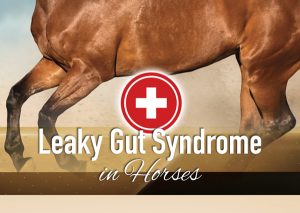Leaky Gut Syndrome in Horses
Click here to read the complete article
244 – January/February, 2022
 By Heather Smith Thomas
By Heather Smith Thomas
The horse’s gastro-intestinal tract is a complex and amazing organ. It performs many functions which include processing and absorbing all the fluids and nutrients that sustain the body, as well as playing a huge role in the horse’s immune system. One of the most important functions of the GI tract is to act as a barrier between the external and internal environment—keeping the “good” stuff inside the body and the “bad bugs” out. Even though feed and water ingested by the horse may contain harmful pathogens, the barrier provided by the GI tract is usually sufficient to keep them from getting any farther, and they pass on out.
Dr. Michael Lindinger, President of the Nutraceutical Alliance (since 2012), and former professor at the University of Guelph for 25 years, has been involved in animal health research for a long time, looking at problems like leaky gut syndrome. He is currently working on nutraceutical product development. “Leaky gut is merely a syndrome, which means there can be a lot of different causes that can contribute to making the gut leaky,” he explains.
“To put this in a human context, when we look at Crohn’s disease or irritable bowel syndrome or even just acute or chronic diarrhea, these are all examples of leaky gut syndrome. This just means that the intestinal wall becomes leaky; fluids are not adequately absorbed into the body from the intestine, and fluids from the body can leak into the intestine—and toxins within the intestine can enter the body and cause many problems. Those leaks can be due to ulcers (such as gastric ulcers in the stomach, or duodenal ulcers, or colonic ulcers) but often if it’s something like diarrhea or irritable bowel syndrome, it’s actually due to a spreading apart of the cells that make up the intestinal walls,” he says.
The intestinal wall is a very thin, single-cell layer that is held together very tightly by firm junctions between the cells and other protein elements. The wall is thin, to make it easier for the body to absorb fluid and nutrients; they only have to pass through a one-cell layer, being transported through and between the cells by very specialized systems.
Click here to read the complete article
244 – January/February, 2022










